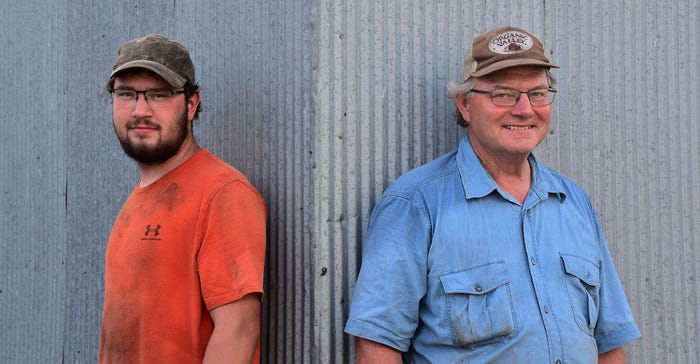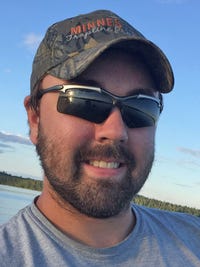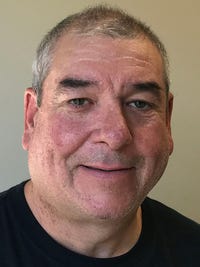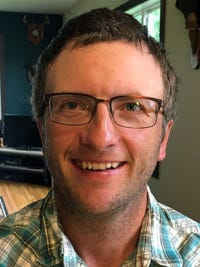August 21, 2020

A first-generation dairy farmer is getting a start in a more efficient and environmentally sound setup with assistance from USDA’s Natural Resources Conservation Service and guidance from the longtime organic farmer whose operation he’ll eventually own.
Jack Schouweiler, 21, is phasing into full-time dairy farming as Ben Wagner, 61, transitions into retirement.
A remodeled parlor-style barn, new manure storage facility and 59 acres of additional pasture for rotational grazing will make chores less back-breaking, allow the dairy to expand, and protect both groundwater and surface water in the Upper Chippewa River watershed.
Schouweiler is remodeling the barn at his own expense. Leveraging a combined $247,000 in Environmental Quality Incentives Program (EQIP) assistance from NRCS and Clean Water Funds from the Minnesota Board of Water and Soil Resources made the manure facility and pasture expansion possible. As a beginning farmer, Schouweiler qualified for higher NRCS payment rates.
“Otherwise, we couldn’t do this,” Wagner says of the NRCS and Clean Water Fund assistance. “I couldn’t afford to borrow that kind of money, and [Schouweiler] doesn’t have the assets to borrow against.”
What Schouweiler does have is a “fire in his belly” for farming, Wagner says, and a talent for working with cattle.
“I’m starting to call him the cow-whisperer. When he works with cattle, they seem to respond to him so easily. He’s got cattle sense that you can’t teach. He’s going to be a better cattleman than I ever was,” Wagner says. “He sees calves are sick before I do. … Heifers, they don’t get startled with him.”
Making connections
Schouweiler grew up on a hobby farm 18 miles from Wagner’s 38-cow organic dairy and has milked cows for more than a dozen other farmers. He wanted a farm of his own.
Wagner’s children had no plans to farm, and he was looking for someone to take over.
They met at the Chippewans 4-H Club rabbit show. Schouweiler was waiting to show his rabbit when he got talking with Wagner’s wife, Jean (the Wagners’ daughters also showed rabbits).
“I wanted to own a farm and Jean said I needed to talk to her husband,” Schouweiler says, recalling that conversation grew so animated that someone yelled at them for talking too loudly during the rabbit show.
Schouweiler was just 14. Wagner wasn’t sure what would come of the conversation.
Two years later, he got a call. It was Schouweiler, wondering when he could start milking.
“With milking, no matter how fast you go, it still takes the same amount of time. It’s just relaxing, the actual milking part of it,” Schouweiler says. “You’ve really got to like cows.”
On June 1 of this year, Schouweiler became the owner of the dairy herd.
It’s one milestone among many in two years of intensive planning. Schouweiler plans to rent — and eventually buy — Wagner’s machinery and land, as cash-flow allows. Meanwhile, Schouweiler is learning about fieldwork and crops from Wagner. Together, they run about 440 acres of cropland and pasture.
Wagner says he could have sold to farmers who would have absorbed his land into the thousands of acres they already run. But he’d improved soil health over the years and didn’t want to see those benefits disappear.
“I want to preserve what I worked for, and [Schouweiler] wants to take it to the next level — and that’s something unique,” Wagner said.
Learning and planning
Together, Schouweiler and Wagner completed a program through the nonprofit Dairy Grazing Apprenticeship and a farm business management program through Alexandria Technical and Community College. Schouweiler earned a two-year dairy management degree from Willmar’s Ridgewater College in May 2019 — the one condition his mother placed on supporting his decision to farm.
“I talk to a lot of older farmers and they [say], ‘Well, I write it up on a sticky note,’” Schouweiler says of tracking business expenses. While a lot of his figuring starts on paper towels, “it’s nice to have those numbers in perspective.”
Ian Olson, the Chippewa River watershed conservation planner based at Douglas Soil & Water Conservation District, has worked with Schouweiler and Wagner on plans tied to Schouweiler’s NRCS applications. Olson was hired as part of BWSR and NRCS’ collaborative Watershed Conservation Planning Initiative.
 CONSERVATION HELP: Ian Olson, the Chippewa River watershed conservation planner based at Douglas Soil & Water Conservation District, work with Schouweiler and Wagner.
CONSERVATION HELP: Ian Olson, the Chippewa River watershed conservation planner based at Douglas Soil & Water Conservation District, work with Schouweiler and Wagner.

Building a new manure storage system to replace a decommissioned manure pit allowed Schouweiler to use the milking barn on the farm he bought from Wagner’s retired brother, Robert, a mile down the road. When the cows move out of Wagner’s tie-stall barn — a setup that’s harder on the back — Wagner will continue to rotationally graze heifers on his farm.
The new 400,000-gallon lagoon at the remodeled barn site has the capacity to hold 12 months’ manure.
Clean water project helps cover costs
Clean Water Funds — part of a $356,960 grant Douglas SWCD received in 2019 to improve drinking water quality by upgrading, replacing or closing out-of-compliance manure pits — covered 75% of the project costs, which included a 60-by-100-foot cement stacking slab with 4-foot-high walls and fenced cattle walkways leading to the pasture.
The area was among those identified through a 2017 Clean Water Fund grant, which led to work in Millerville Township and parts of Ida and Leaf Valley townships.
Douglas SWCD initially targeted the area based on Minnesota Department of Health nitrate testing of 1,864 wells in nine Douglas County townships. On average, 1.7% of the wells tested exceeded the state’s allowable limits. MDH has linked nitrate to blue baby syndrome.
“By either eliminating existing pits that aren’t in compliance or [reconstructing] those that are still being used, the groundwater resources in that area will be better protected,” says Jerry Haggenmiller, Douglas SWCD coordinator. “As a secondary bonus, any runoff into surface waters will be corrected by these ag waste system upgrades.”
 WATER QUALITY RESOURCE: Jerry Haggenmiller, Douglas SWCD coordinator, works with farmers on ag waste containment systems.
WATER QUALITY RESOURCE: Jerry Haggenmiller, Douglas SWCD coordinator, works with farmers on ag waste containment systems.

The Upper Chippewa River watershed in Douglas County consists of dairy farms, cropland, wetlands and lakes set amid rolling hills. Land-use and topography make the area more vulnerable to nitrate pollution.
The 130-mile-long river flows from Otter Tail County to the Minnesota River at Montevideo. Its watershed encompasses 2,080 square miles in parts of Otter Tail, Douglas, Grant, Pope, Stevens, Swift, Kandiyohi and Chippewa counties and a bit of Stearns County. Among the concerns within the watershed are sediment, phosphorus, nitrogen and bacteria.
“Whatever protection we can do here is going to benefit everybody all the way down,” Haggenmiller says.
Turning to pasture management
Converting marginal cropland to pasture is among the protections that benefit water quality.
NRCS grazing lands specialist Jeff Duchene writes 70 to 100 grazing plans a year for producers within 20-some northwestern Minnesota counties including Douglas County. Over the past 10 years, he says rotational grazing has caught on throughout the region.
“As you get more people implementing better grazing management, it seems like you just get more interest,” Duchene says. “Then I think the farming environment has changed, where people see the value of doing things differently.”
 GRAZING RESOURCE: NRCS grazing lands specialist Jeff Duchene writes 70 to 100 grazing plans a year for producers within 20-some northwestern Minnesota counties including Douglas County.
GRAZING RESOURCE: NRCS grazing lands specialist Jeff Duchene writes 70 to 100 grazing plans a year for producers within 20-some northwestern Minnesota counties including Douglas County.

As land values increased, Duchene says producers turned to pasture management as a way to raise more animals on existing acreage. Commodity prices were another factor.
Duchene initially worked with Wagner to establish his rotationally grazed pasture. His most recent 50-acre enrollment — bordering a wetland, with steep slopes that made it difficult to farm — grew out of a discussion during a field day Wagner hosted a few years ago. Schouweiler enrolled 9 acres of the land he’s renting.
“Probably the biggest challenge on [Wagner’s] site was the soil wetness. He’s got a couple wetlands near the farm site that the pasture goes around. He had been trying to farm some of those soils. It was poorly drained and marginal cropland,” Duchene says. “With well-managed grazing, you can really minimize your impact as far as water quality and reduced soil erosion.”
Grasses will grow where crops were spotty. EQIP assistance will offset expenses tied to seeding, extending water lines and fencing.
By buffering the wetlands, the pasture will decrease the potential for runoff. While that land may be too wet for grazing part of the year, Duchene says it will serve as drought insurance — remaining productive longer, even if it doesn’t rain for a few weeks. The site will balance some of the drier upland pasture on Schouweiler’s rented farm.
The new setup plus more pastureland will make it possible for Schouweiler and Wagner to eventually milk up to 70 cows.
“I feel so blessed that this has happened,” Wagner says. “I don’t know how I’d be running the farm without his help.”
Grant and planning details
Here are some specifics on what Jack Schouweiler’s plans are as he gradually takes over Ben Wagner’s organic dairy operation:
Upper Chippewa grant. Douglas SWCD’s $356,960 Clean Water Fund grant from BWSR will protect groundwater and improve water quality in the Upper Chippewa River watershed by upgrading, replacing or closing existing damaged or unpermitted manure storage areas. It will also help address feedlot runoff. In addition to Schouweiler’s project, four manure pits have been closed; two more are set to close this year. Eligible projects included feedlot runoff control structures, feedlot fencing and stacking slab construction. The 10 projects would reduce nitrogen by an estimated 421 pounds and phosphorus by an estimated 122 pounds a year. Grant funds can cover up to 75% of a project’s cost.
Watershed Conservation Planning Initiative. Ian Olson is one of seven conservation planners working in watersheds across Minnesota as part of an NRCS-BWSR-SWCD collaboration. The Watershed Conservation Planning Initiative was designed to help producers gain a comprehensive view of their land and the resource concerns they might have. Planners work with producers to develop a whole-farm assessment. Implementation is voluntary. Plans are meant to increase landowners’ readiness to implement conservation practice when the opportunity arises.
Cover crops and grazing. Jeff Duchene, NRCS’ grazing lands specialist covering northwestern Minnesota, considers cover crops when he works with producers to get more grazing days out of their operation. Improved pasture management means improved land productivity — and more profitability.
“A lot of producers get in the mind-set that your pasture is pasture and your cropland is cropland,” Duchene says. Incorporating cover crops can increase grazing days — by grazing crop residue, or by growing cover crops to be grazed.
“I think once you start looking at both your perennial pasture resources and any cropland or hay land you may have access to, you can develop a more well-rounded system,” he says. “You just get a lot of options.”
In Minnesota, NRCS grazing plans call for at least five months of grazing.
“I think seven months could be a very feasible goal for a lot of operations,” Duchene says.
Even a couple of weeks more grazing could be more economical. One factor in developing a grazing plan is how much time the producer can spend on management. Some use drones and phone apps to help with livestock and pasture management.
Wessel is an information officer with the Minnesota Board of Water and Soil Resources in Waite Park.
Source: Minnesota Board of Water and Soil Resources, which is solely responsible for the information provided and is wholly owned by the source. Informa Business Media and all of its subsidiaries are not responsible for any of the content contained in this information asset.
You May Also Like




